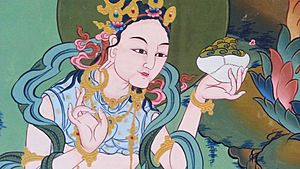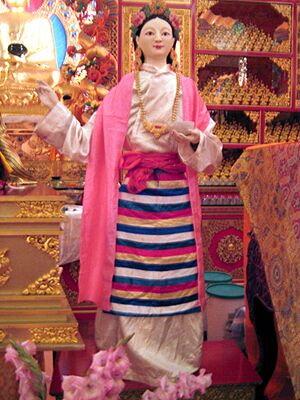Yeshe Tsogyal facts for kids
Quick facts for kids Yeshe Tsogyal |
|
|---|---|

Yeshe Tsogyal
|
|
| Religion | Tibetan Buddhism |
| Yeshe Tsogyal | |||||||||
| Tibetan name | |||||||||
|---|---|---|---|---|---|---|---|---|---|
| Tibetan | ཡེ་ཤེས་མཚོ་རྒྱལ | ||||||||
|
|||||||||
| Chinese name | |||||||||
| Traditional Chinese | 益西措傑 | ||||||||
| Simplified Chinese | 益西措杰 | ||||||||
|
|||||||||
Yeshe Tsogyal (born around 757 or 777 CE, died 817 CE) was a very important woman in Tibetan Buddhism. People called her "Victorious Ocean of Knowledge" or "Knowledge Lake Empress." Her Sanskrit name, Jñānasāgara, also means "Knowledge Ocean." She was also known as "Lady Kharchen" because of her family.
Yeshe Tsogyal became enlightened during her lifetime. Many people see her as the "Mother of Tibetan Buddhism." She is the most important woman in the Nyingma Vajrayana lineage, which is a type of Buddhist teaching. Some stories say she was a princess who married Trisong Detsen, the emperor of Tibet.
She began studying Buddhism with Padmasambhava, who was her main teacher. Padmasambhava helped start the Nyingma tradition of Tibetan Buddhism. He is seen as a very important Buddha for our time. Yeshe Tsogyal helped Padmasambhava write down special teachings called terma. She also hid many of these teachings herself for people in the future to find.
Yeshe Tsogyal was born a princess in Kharchen, Tibet, around 777 CE. She tried to avoid arranged marriages but was eventually brought to marry Emperor Tri Songdetsen. She lived for about 99 years. She is a key figure in the Nyingma school of Tibetan Buddhism. She is also a great role model for people who practice Buddhism today. Even though she is often called Padmasambhava's main partner, Yeshe Tsogyal was a powerful spiritual teacher on her own.
Because of her amazing spiritual achievements, the Nyingma and Karma Kagyu schools of Tibetan Buddhism believe Yeshe Tsogyal was a female Buddha.
Contents
Her Life Story
Yeshe Tsogyal is a very important person in Tibetan Buddhism. Many people wonder if she was a real historical figure. There are several books about her spiritual life translated into English and French.
Even if we don't have all the historical proof, her life story is full of rich details for those who follow her spiritual path. Here are some stories about her birth:
According to old tales, Yeshe Tsogyal was born in a special way, much like the Gautama Buddha. A sacred sound was heard as her mother gave birth without pain. People believe she was a reincarnation of the Buddha's own mother, Maya. Her name, "Wisdom Lake Queen," comes from a legend that a nearby lake doubled in size when she was born.
From a young age, Yeshe Tsogyal wanted to focus on spiritual practice. She did not want to marry. She felt so strongly about this that she ran away. But she was brought back by force. When she was sixteen, she was made to marry the emperor of Tibet, Trisong Detsen.
After their marriage, Emperor Tri Songdetsen invited Padmasambhava to Tibet from India. He wanted Padmasambhava to teach Buddhism. The emperor then offered Yeshe Tsogyal to Padmasambhava. Padmasambhava set her free, and she became his main student and spiritual partner.
Her Spiritual Journey
A Woman's Path to Enlightenment

Yeshe Tsogyal is a very important role model for women who practice Tibetan Buddhism. She once asked about her "female body" and if it was a problem for spiritual growth. Many people at that time thought a woman's body was a hindrance.
But Padmasambhava told Yeshe Tsogyal that a woman's body is actually helpful for enlightenment. He said, "The way to become enlightened is through a human body. Being male or female does not make a big difference. But if a woman truly wants enlightenment, her body is even better."
After many years of deep study and meditation, Yeshe Tsogyal reached the same level of spiritual awakening as Padmasambhava.
Her Spiritual Practices
Yeshe Tsogyal spent many years meditating alone in isolated places. She completed several types of tantric spiritual practices. She learned these from Padmasambhava and other wise beings. These practices included Vajrakilaya, Zhitro, tummo (inner heat), and karmamudrā practice.
All these practices helped Yeshe Tsogyal reach awakening. Many ordinary Tibetans believe she is a fully enlightened Buddha. They think she chose to appear as a normal woman so that everyday people could connect with her.
Her Students
When Yeshe Tsogyal passed away, she had eleven main students. These students were both women and men. Some of her main students included:
- Karchen Zhonnu Dronma
- Monmo Tashi Khyidren (from Bhutan)
- Shelkar Dorje Tsomo (from Shelkar)
- Be Yeshe Nyingpo
- Ma Rinchen Chok
- Odren Zhonu Pel
- Langlab Gyelwa Jangchub Dorje
- Lasum Gyelwa Jangjub, or Atsara Sale
- Darcha Dorje Pawo
- Ukyi Nyima (from central Tibet)
- Queen Li-za Jangchub Dronma (from Khotan), who was also Queen of Tri Songdetsen
Yeshe Tsogyal gave her final teachings because these eleven main students asked her to.
Other important students from Tibet included King Mutri Tsenpo and Princess Ngang-chung Pelgyi Gyelmo. Students from Nepal included Jila Jhipa, Vasudhara, and Śākya Dema. She also taught Gelong Namkhai Nyingpo in Bhutan.
Besides the eleven main students, about 79 other students were present for Yeshe Tsogyal's final teachings. Some sources say there were at least 100 people there.
Later Appearances
Yeshe Tsogyal is also seen as a special form of the Bodhisattva Tara. She is also believed to be a manifestation of Samantabhadrī, Prajnaparamita, and Vajrayogini.
In a book called Life of Yeshe Tsogyel, Padmasambhava said that Yeshe Tsogyal would be reborn as Machig Labdrön. Her spiritual partner, Atsara Sale, would become Topabhadra, Machig’s husband. Her helper, Tashi Khyidren, would be reborn as Machig’s only daughter. All the important people in Yeshe Tsogyal’s life were to be reborn in the life of Machig Labdron, even Padmasambhava himself, who would become Dampa Sangye.
Images for kids
See also
 In Spanish: Yeshe Tsogyal para niños
In Spanish: Yeshe Tsogyal para niños
- Khandro Rinpoche
- Lady of the Lake
- Lamrim Yeshe Nyingpo
- Mandarava
- Urgyen Tsomo


